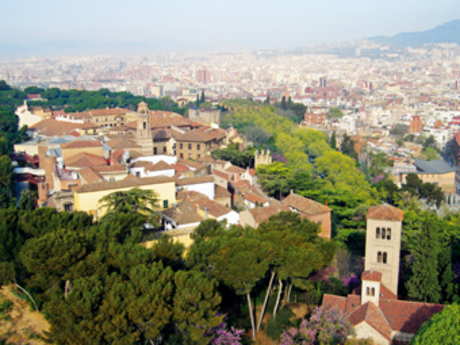Poble Espanyol
The Poble Espanyol (Spanish Village) was built for the 1929 International Exhibition in Barcelona on the Montjuïc hill. Its aim was to show visitors a representative sample of Spanish architecture.
From the beginning, it was conceived as a real "village" in the middle of a city, with a surface area of 49,000 m2. The aim was to give an idea of what might be an "ideal model" of a Spanish village containing the main characteristics of all towns and villages in the peninsula. For this reason, 117 buildings, streets and squares were reproduced to scale. Pieces were selected taking into account criteria of aesthetic fit that could help create a harmonious overall composition in accordance with the "village" design that had been conceived.
The idea was championed by the architect Puig i Cadafalch and then designed as a whole unit by the architects Francesc Folguera and Ramon Reventós, with the participation of the art critic Miquel Utrillo and the painter Xavier Nogués. It was built in thirteen months and, strangely, the work had an expiry date, as it was supposed to last the same time as the Universal Exhibition – six months. Its success in planning terms, however, has allowed this open-air museum to remain alive until our time.
A team of two architects, an engineer and an artist created the Poble Espanyol by erecting 116 buildings in different architectural styles representing Spain's many regions. The village features a large square, the Plaza Mayor, and a couple smaller squares connected by picturesque streets, some with stairs. It includes a town hall, a church, a monastery, shops and residential buildings.
Several of Poble Espanyol's buildings are exact reproductions of existing buildings, while other merely represent a specific architectural style. The main entrance gate to the village is a replica of the Puerta San Vicente, one of nine gates of the 11th century walls around the city of Avila. Some other notable replicas are the Town Hall of Valderrobres and the tall clock tower of Utebo, a mixture of Mudéjar and gothic styles.
El Poble Espanyol was only built for the duration of the Exhibition, but due to its popularity it was not demolished. Except during Spain's civil war, when it was used as an internment camp for prisoners, it has continued to attract visitors lured by the car-free idyllic village.
In 1988 the village was renovated and several attractions were added. There is now a focus on traditional arts with artisans creating glass, decorative paintings, ceramics, embroidery, and many other handmade objects in about 40 workshops. The village also features a number of bars, restaurants, shops and even some nightclubs.
Poble Espanyol, also known as “The Spanish Village”, is beautifully located on mount Montjuïc. The small village functions as an oasis in the heart of Barcelona. When entering, visitors will be moving from the modern city landscape to a unique and diverse village made of Spanish history.
This site contains representations of all different architecture, culture, lifestyle and craftsmanship from the regions of Spain, mixed together in harmony to look as if it was a real town. If one wants to learn a lot about Spain in a period of short time then this is definitely the right place.
Today, the Poble Espanyol is a beautiful cluster of workshops and restaurants. In total, the village consists of over 100 traditional buildings. Many say that this is the place to go in order to find a special gift or souvenir from Barcelona.
Since its inception, the Poble Espanyol has been considered one of Barcelona’s unique attractions. Its layout – a real village with a diversity of streets and squares, free of traffic and surrounded by nature – has helped create a special microcosm where art, leisure and culture play a prominent role. First and foremost, the Poble Espanyol gives you the chance to see a diversity of houses, squares and landmark buildings from throughout Spain, from an Aragonese church to an Andalusian quarter, brought together on one site with an audioguide to help you find your way around.
You’ll also find over 40 arts and crafts workshops (jewellery, glass, masks, embroidery, puppets, leather goods, ceramics…), selling one-off, signature pieces. Because of its commitment to keeping traditional crafts alive, Barcelona’s Poble Espanyol has been declared an Area of Craft Interest by the Catalan government. You’ll also find original shops and wide variety of Mediterranean cuisine. The “Poble for Kids " programme organises activities such as performances and children’s workshops and a treasure hunt, the "Joc del Sarró", a family activity which reveals the secrets of the Poble Espanyol in a fun and informative way.
Poble Espanyol offers one of a kind experience. Don’t miss it while in Barcelona and take the tour across the village. Placed on the Montjuic Hill it’s easily accessible for tourists and there are plenty of hotels where you can book a reservation and take a rest. Beside the notable sights, Poble Espanyol offers also educational programs, entertainment for your kids and various places to have a drink and feel the vibe of the city. You can get there via direct flight to Barcelona or to Girona, Reus or Lleida –Alguaire.



